360-degree cylindrical aquariums enhance zoo experiences with immersive views and improved animal welfare. Customizable themes, lighting, and decorations craft stunning exhibits. Ideal for diverse aquatic displays, these aquariums provide practical, engaging zoo solutions while prioritizing both visitor experience and animal well-being. Meticulous installation and maintenance ensure captivating marine life presentations.
“Unleash the awe-inspiring power of nature with 360-degree cylindrical aquariums—stunning focal points that transform any space into a vibrant, immersive ecosystem. This article explores the innovative design and aesthetics of these colossal structures, highlighting their functionality for zoos and animal welfare considerations. From installation to maintenance, we provide a comprehensive overview tailored for zoo professionals seeking cutting-edge aquarium solutions. Discover how these circular aquariums enhance visitor experiences while meeting the unique needs of diverse species.”
Design and Aesthetics: Creating a Captivating Visual Experience
Design and aesthetics play a pivotal role in creating captivating visual experiences with 360-degree cylindrical aquariums, making them ideal for zoos looking to enhance their exhibits. These aquariums offer a unique perspective by allowing viewers to immerse themselves in the aquatic world from all angles, providing a truly breathtaking spectacle. The circular design creates a sense of continuity and fluidity, where fish and marine life appear to glide effortlessly around the entire perimeter, captivating audiences with its beauty.
Aesthetically, cylindrical aquariums can be tailored to complement various zoo themes, from serene underwater landscapes to vibrant coral reefs. Customization options include lighting effects that mimic natural sunlight or create dramatic contrasts, along with strategic placement of plants and decorations to replicate natural habitats. This level of design flexibility ensures zoos can craft visually stunning exhibits that educate and enchant visitors while showcasing the beauty and diversity of marine life in an innovative way.
Functionality for Zoos: Benefits and Practical Considerations
Zoos around the world are increasingly recognizing the value of 360-degree cylindrical aquariums as stunning and functional additions to their exhibits. These unique structures offer a panoramic viewing experience for visitors, providing an immersive encounter with aquatic life. Beyond aesthetic appeal, there are several practical benefits for zoos considering this design.
Firstly, aquariums for zoos allow for more natural habitat replication, enhancing the welfare of aquatic species by mirroring their natural surroundings. This can lead to improved animal behavior and health. Secondly, the cylindrical shape facilitates better water circulation and quality management, which is crucial for maintaining a healthy aquatic ecosystem. Additionally, these aquariums offer versatile exhibition opportunities, accommodating various species and themes, from coral reefs to deep-sea environments. Such adaptability allows zoos to create dynamic and engaging exhibits that captivate audiences.
Species Accommodations: Meeting Animal Welfare Needs
360-degree cylindrical aquariums, with their breathtaking panorama, offer a unique twist on traditional aquarium design. When it comes to species accommodations, these structures must prioritize animal welfare. For zoos and wildlife conservation centers, incorporating 360-degree aquariums allows for more immersive environments that meet the specific needs of various aquatic species.
This design accommodates natural behaviors like swimming in circular patterns and vertical climbing, enhancing quality of life. By providing ample space and stimuli, these aquariums promote healthy mental stimulation, reduce stress, and support the overall well-being of aquatic animals. They also facilitate better visual contact for visitors, offering a captivating experience that highlights the beauty and diversity of underwater ecosystems.
Installation and Maintenance: A Comprehensive Overview
Installation and maintenance of 360-degree cylindrical aquariums, often used as stunning focal points in zoos, requires meticulous planning and dedicated care. The initial setup involves careful positioning to ensure structural integrity and water balance. This includes preparing the tank, installing filtering systems, heating elements, and lighting fixtures tailored for aquatic habitats. Regular maintenance tasks include monitoring water quality parameters like pH levels, ammonia, nitrite, and nitrate concentrations. Additionally, routine cleaning of the aquarium glass, filtration media, and decorative elements is crucial to prevent algae buildup and maintain a healthy environment for the inhabitants.
For zoos, regular feeding schedules and health checks for the aquatic species are integral parts of maintenance. Monitoring water temperature, adding necessary supplements, and promptly addressing any signs of illness or distress are essential practices. Moreover, periodic partial water changes help maintain optimal conditions. With proper care, these cylindrical aquariums can showcase diverse marine life captivatingly, providing both educational opportunities and awe-inspiring experiences for zoo visitors.
360-degree cylindrical aquariums offer a unique and captivating visual experience, transforming zoos into destinations that blend natural beauty and cutting-edge design. By enhancing animal welfare through innovative species accommodations and practical functionality benefits, these aquariums become essential tools for modern zoos. With proper installation and maintenance, they promise to revolutionize zoo landscapes, providing both educational value and aesthetic allure for years to come, making them a game-changer in the world of aquariums for zoos.
